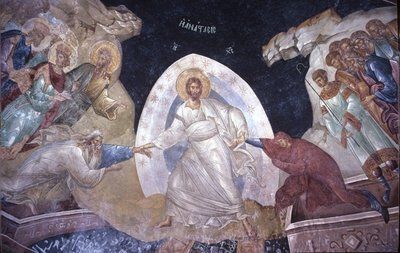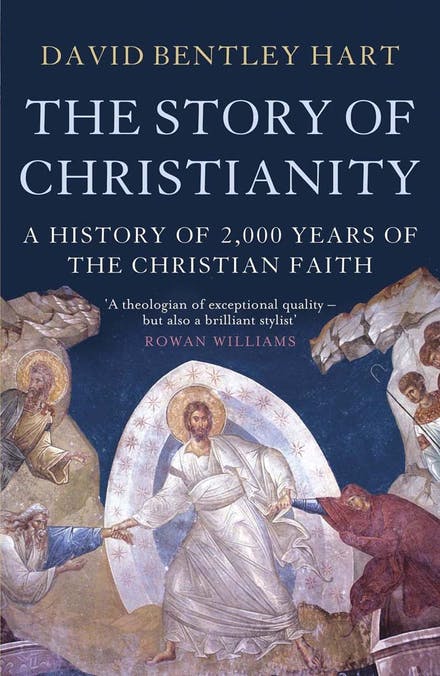Notes on The Story of Christianity by David Bentley Hart

I first came across David Bentley Hart from a review he wrote of Robert Alter's recent translation of the Bible. In it he complained about the trials one must endure when they attempt such a translation, having to contend with, amongst other things, theologians who "will try to marshal the few stray atoms of linguistic training they got in seminary to 'correct' the new version" and the "legions of the faithful who, on the basis of dogmatic formation, religious schooling, profound conversion experiences, or private inspiration, will feel themselves competent to pronounce upon the translator’s work with an authority only slightly less magnificent than God’s."
And so I recognised him as a writer who could easily set their confessional leanings aside and comfortably operate in the mode of the jaded cynic, happily excoriating those who parade nonsensical or unjustifiable claims in the name of their religious convictions. A history of Christianity written in this style would certainly be a thing to behold.

So I was initially disappointed in The Story of Christianity. Apparently, it was adapted from an illustrated edition for a trade paperback release, and it shows. The writing isn't very lively or focused, the digressions feel out-of-place, and the lack of any illustrations really hampers the text. (It's odd, for example, to read about the Hagia Sophia without any accompanying images.) I also wasn't encouraged by the number of typos I found, and I suspect the conversion process was a bit of an editorial hack job – I imagine the illustrated hardcover edition would look a lot better by comparison.
I was also disappointed that, despite the subtitle, this is not really a history. It's heavily segmented, with no narrative thread or central thesis tying everything together. There are no footnotes or endnotes, and few in-text references to primary sources (and none to secondary materials). The further reading section is a bit scant, and there is virtually no discussion of the historiography. There's really not much to direct students towards further reading, or any hint at debates in the scholarship, and so it's difficult to judge just how competent Hart is as a researcher without delving further into the secondary literature.
But it did grow on me. There is great breadth to this book. It's composed of fifty short chapters, each of which offer a light treatment of its topic. The obvious subjects are covered – Constantine the Great, the Great Schism, the Reformation – but Hart gives equal treatment to less well-known subjects, such as the Desert Fathers, the Gnostics, and the conversion of the Slavs. Correspondingly this book examines many neglected topics and loosely gathers them together, which I touch on below.
The Resurrection Enigma
Christians believe that Jesus died on Good Friday and was resurrected on Easter Sunday. The historical consensus is that the resurrection didn't happen, but this leaves us with a difficult question – why didn't Jesus' followers disband after his death, but instead carried on with vigour? Or, as Hart puts it:
Considered purely as a historical phenomenon, the abrupt transition of Christ's followers from a posture of utter defeat and disillusionment to one of triumphant jubilation constitutes an altogether impenetrable enigma.
Hart strongly hints that the answer to this enigma is that the Apostles witnessed a true resurrection which bound them together in elation. (As an aside, The Story of Christianity is largely disinterested with viewing Jesus' ministry 'purely as a historical phenomenon', and Hart seems to take a lot of the Gospel claims about Jesus at face value.) I don't agree that this is a likely explanation, but I think the enigma itself is very much a real one for historians to contend with and I appreciate how Hart frames it in these terms.
Theological Musings
Christianity was, theologically-speaking, pretty thin on the ground at first. As it was based on the teachings of an Aramaic Jewish preacher, which were then reinterpreted by a Hellenised Jew for a Greco-Roman audience, developing a consistent, universal theology from those materials would have been no simple task.
Hart does an admirable job of laying out the debates, personalities and developments in this undertaking for doctrinal coherence, from Origen and the Desert Fathers to Thomas Aquinas and Martin Luther, to which he partially credits the early success of Christianity against Roman paganism.
Of particular interest for me were the chapters where he examines the theological controversies (such as monophysitism and iconoclasm) that led to the various schisms, and details how they exacerbated existing political and cultural-linguistic differences between the churches. I found these chapter to be particularly valuable, given how Christian theological disputes can be so readily trivialised (by Christians of rival confessions as much as by the more cynical atheists), and Hart's even-handed commentary here is very welcome.
Diversity of the Faith
Medieval Christianity is commonly associated with the Catholic and Orthodox faiths. But Hart points out that Christianity had spread far and wide in its early centuries before it took hold in Rome, where it endured in large and small communities throughout North Africa and Eurasia.
- The oldest Christian kingdom is, in fact, Armenia, whose royal household converted to the faith circa 300CE, and broke with the Roman and Greek Churches in 506CE.
- Christianity was established in India quite early, perhaps as early as the First Century CE, along the Malabar Coast. These Malabar Nasrani, or Saint Thomas Christians, were fortified by East Syrian Christians refugees fleeing various prosecutions, and have endured until today.
- A lot of attention is also heaped on the East Syrian Church, which is often left out of the narrative of Christendom even though it was, for a time, the largest of the churches in geographical terms. (Hart explains how it was rapidly diminished by Muslim expansion, particularly after the Mongols converted to Islam.)
- There's also the Ethiopian Church, which dates to the time of the Aksumite empire in the Fourth Century, and the Coptic Church, which was founded in the First Century.
On a related note, I also appreciated all the digressions about church architecture across various regions and time periods. Although, as previously noted, the lack of any illustrations really hurt this aspect of the book.
Misgivings and Conclusion
The Story of Christianity is not a brilliant work of scholarship, or even a very serious general history, but it is a handy resource if you want to get a sense of the scope of Church history or familiarise (or re-familiarise) yourself with the beats of the Christian past.
However, it requires a careful reading as Hart doesn't always restrain the impulse to indulge in apologia. At times this is relatively harmless – he takes some miraculous accounts at face value – but his efforts to absolve Christianity of wrongdoing veer into intellectual and moral cowardice.
While he is happy to attribute the excesses of Stalin's reign to atheism, for example, he denies any blame for the Holocaust on Christianity. Although he acknowledges that Nazi anti-Semitism had its roots in European anti-Semitism, he ultimately locates Nazi ideology with "Germanic neo-paganism and the pedigree of 'scientific' socialism". This failure to contend with the consequences of Christian anti-Semitism, and their influence on European society, is profoundly disappointing.
On a more complimentary note, the book ends on the observation that there are, more than ever, greater numbers of Christians outside Europe than within, and these Christians will go on to define Christianity going forward. I think this closing note exemplifies DB Hart's universal approach, which is to contend with Christianity as a vast, diverse, complex entity which justifies a broad engagement with its culture, ideology, aesthetics and history.


Comments ()